The day did not belong to the lake nor the river. It belonged to a little mud bowl, nestled deep within the nearby State Fish & Wildlife Area. It wasn’t that far from the main lake, nor was it well hidden off the beaten path. But it was wide awake. And I was the only visitor.
The storms had done their work. Over the past 7 days, we’d collected enough rain to raise the river level by 4 feet. I had planned a wade, but if you’ve ever fished a river after rain like this, you know just how unproductive the rushing chocolate milk can be. Not to mention dangerous.
The river was out.
My clear borrow pits? Dingy and cloudy. At times, rain can fire up a lake as it washes fresh bugs and food into the water, activating the entire ecosystem. But our recent rains were heavy. Pushing loads of dirt and debris into the crystal-clear water. As I stood on the bank, I could see just how much the visibility had reduced. A situation like this can quickly put the fish in a foul mood. As I peered into the water from the ramp, it was as if the lake were whispering, “Not today.”
The lake was out.
As a father of five with a full-time job, fishing time is limited. If a day is set aside to fish, we’re going fishing one way or another. Fishing fathers must always be thinking ahead – and success on the water often depends on preparation and adaptability. Based on my conditions, there was only one option… Pond hopping.
I slid my featherweight kayak off the tailgate and belly-dragged it through the shin-high grass. As it kissed the edge of the pond, the possibilities raced through my mind. There was no ramp, no dock, no parking signs or garbage cans – just a cut in the grass where the water met the land. In the distance, I could hear the sound of a truck speeding past the area, unaware that the little mud-bowl even existed – or held fish.
It did.
Ten strokes of the paddle and I had enough room to move freely. Bluegill were present, as were heron and several chattering, territorial, red-winged blackbirds. They scolded me as I skimmed along the surface, making my way around the perimeter and lobbing careful casts close to – but not in – the overhanging bushes that lined the shore.
Visibility? Inches. But it’s always like that here, so the Bass rebound after storms faster than they do elsewhere. These fish shrug when others panic, as the change to their environment isn’t as dramatic.
Another cast to an exposed laydown sticking above the water. My floating topwater kicked and sputtered as I slowly and methodically reeled it back to my kayak, until…
Ka-Boom!
The world flipped. Water splashed and heaved as a Largemouth detonated my offering – no more than two rod lengths from where I sat! Close-quarter, hand-to-hand combat was underway. I leaned back and set the hook. The kayak spun and line ripped free from the spool. After weeks of fishing deep finesse, this was like a bar fight with no rules – and I couldn’t contain my laughter.
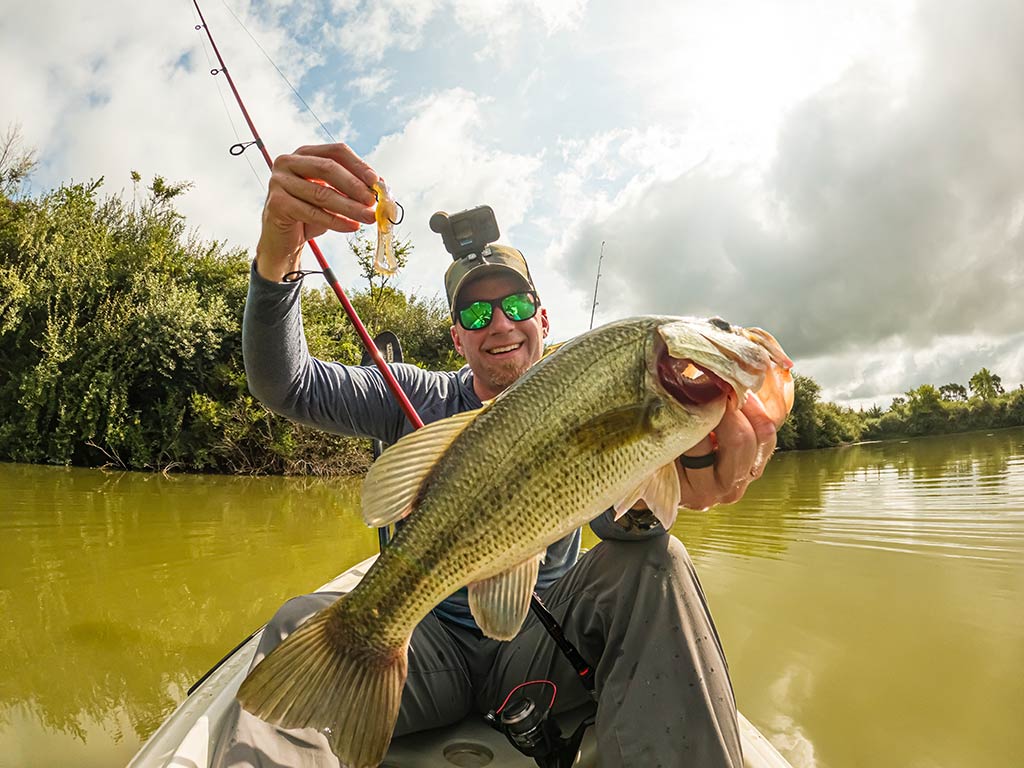
Within seconds, a healthy, hefty, pale Largemouth came into the kayak with me. We sat for a second, staring at one another as the same territorial blackbird screeched at us for making such a ruckus on his quiet pond.
This was the right decision.
When the rain comes and the river rises… When your lake becomes a muddy mess and the sight-feeders shut down… These are the days that a featherweight kayak and a fishing portfolio come into play for every father who loves to go fishing. Location diversity is as crucial as cover diversity, and the same 80/20 fishing rule that I apply to my tackle comes into play when I’m building a collection of locations.
So, if you’re fishing on borrowed time between board meetings and bedtime stories, put these techniques into play to open up an entirely new world of fishing opportunities and success:
Technique #1: Build your Fishing Portfolio
We talk endlessly about collecting more stuff. More baits, more rods and reels, the latest and greatest… But one of the mindset shifts that I try to get anglers to really consider is collecting experience. Much like leveling up a video game character, more time on the water and more casts while being more observant leads to improved skills. Your skill level is more important than your gear. Some facets of fishing have become high-end and elitist (like forward-facing sonar, for example). But fishing, at its core, is a blue-collar sport. That means that anyone, no matter their background, can catch big fish.
Luck plays a role. But for fathers fishing on borrowed time, developing a fishing strategy is everything. Increasing your skill ups your odds dramatically. This is what minimalist fishing is all about. Anyone can do it. Everyone can benefit from it – except for the fish!
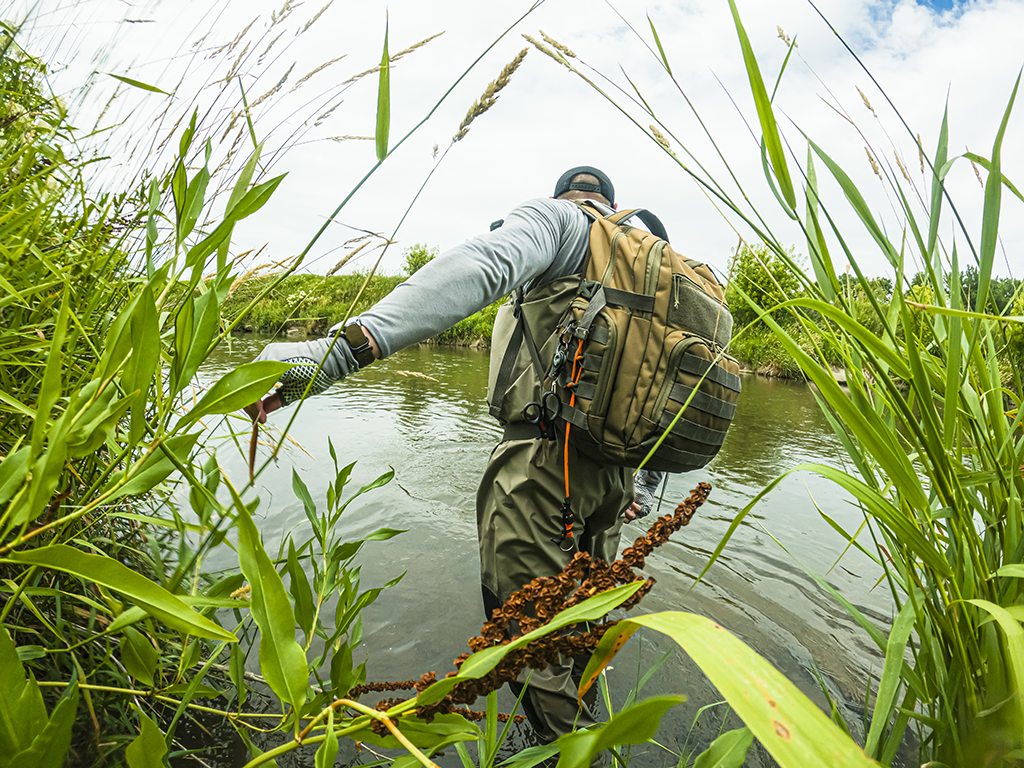
One of the skills that I started to develop a few years back was collecting water. It sounds nuts, but what I mean is spending some serious time on Google Earth and exploring every area within 50 miles of your location. When you see a small body of water, mark it. Plan to explore it. Don’t trespass, of course, but if you can fish it, do so. You might find fish. You might not. But in time, you’ll begin to create your fishing portfolio – your own personal collection of locations that behave differently as the seasons change, that react differently to current weather conditions, and that put up different species of game fish.
Just as a diversified investment portfolio acts as a hedge against volatility (another fatherly responsibility), a diversified fishing portfolio acts as a hedge against weather, pressure, and mood. A collection of rivers, creeks, lakes, and ponds puts all kinds of fishing right within arm’s reach! It allows you to maximize your fishing time and avoid getting rattled by the conditions. This is essential for dads who might only get a few short windows to fish each month. When time is short and conditions change, the last thing you want is to waste your shot.
Different waters will have fish in different stages (pre-spawn, spawn, post-spawn, etc.) at different times. And these different waters will allow you to fish with different techniques.
There’s no downside to beginning to build your own fishing portfolio! Here are a few quick tips:
- Map fast and drop pins to explore. Seek out public ponds, creeks, rivers, and backwaters – anything that looks fishy.
- Classify each area: clarity, cover, ease of access, wind exposure, and inflow/outflow.
- Wargame: Run through storms and other scenarios in your head and imagine how this location might react.
- The two-spot rule: Never leave home without a backup plan. If the place you wanted to fish is compromised, simply pivot.
Technique #2: Featherweight Fishing Tactics
Travel light. Hunt quiet.
Sound travels far and fast underwater. Every bump, click, move, or ripple gets noticed. You think the fish don’t know you’re there? They do. You must be as quiet as a church mouse.
Of course, that’s easier said than done.
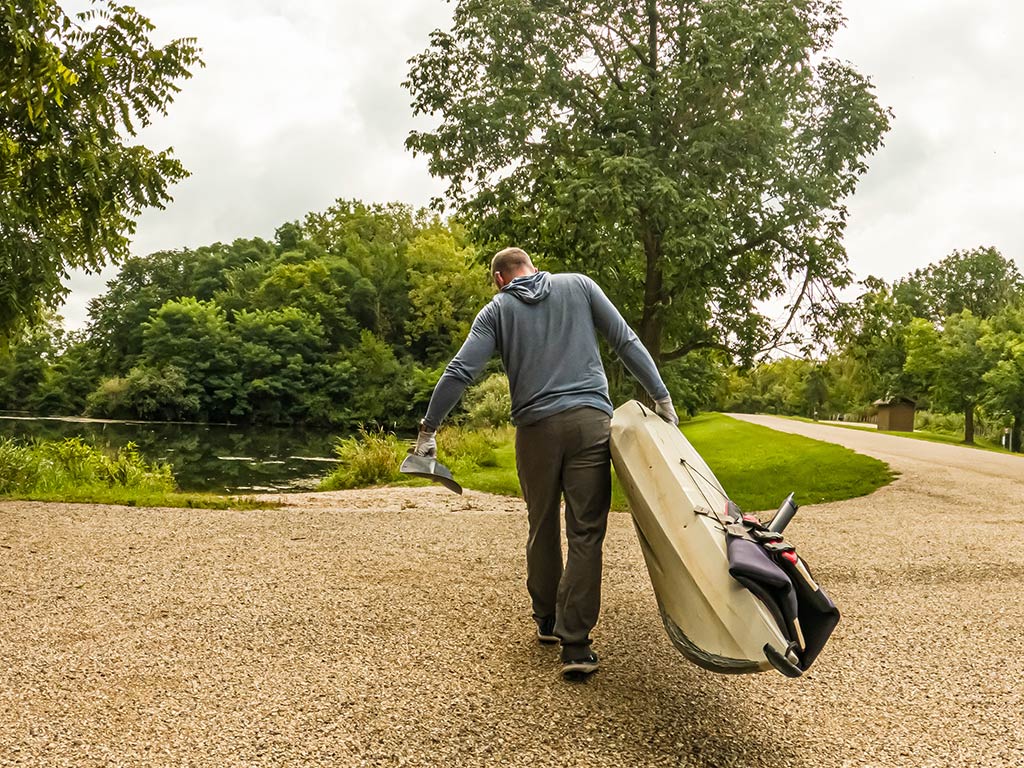
My plastic kayak has been through it all. I’ve patched holes to keep her afloat, but she’s old and squeaky – like a crusty screen door in a haunted house. While this is frustrating, it has also helped to train my actions. When I’m in the kayak, I make small, controlled movements – because I have to if I want a real chance at catching a big fish. This is more or less true in different water conditions. Fishing clear Wisconsin water requires a specialized approach, just like fishing the Midwest muck.
But before you can fine-tune your approach, you have to have access to the water itself. This is where a featherweight kayak shines.
When you’re a father fishing between baseball games and dance recitals, access matters more than horsepower. Plus, as you develop your fishing portfolio, you’ll likely come across amazing bodies of water that are public but extremely hard to access. There are pros and cons here…
On one hand, you’ve got some hard work in front of you. Probably some ticks, bloodied hands, and loads of mosquito bites. On the other hand, big, fat Bass roam these waters unpressured – and they like to eat.
Having access to a light kayak that can enter these places opens up a whole new world of opportunity. Take this, a pre-loaded base box, a single multi-purpose rod, and you’re ready to fish while maintaining maximum mobility.
Approach like a heron! Your light kayak allows you to move silently, both on land and on the water. These are superpowers. Use them.
Technique #3: Splash, Thump, Pulse
I always plan to approach any body of water I’m fishing at three different depths: top, middle, and bottom. However, the clarity and cover dictate which presentations will fit the bill. We know that big Bass love the muck, but they also love deep rocky humps and tall weeds in clear water. These unique conditions demand unique presentations.
When I’m fishing topwater, dirty water gets more commotion – flappies, bloopies, splash… Something that they can locate. However, in extremely clear water, I’ll lean into downsizing or speed. Fast-moving baits that walk along the surface can get a reaction strike, while 2″ poppers can spit and sputter gently, drawing in hesitant brutes.
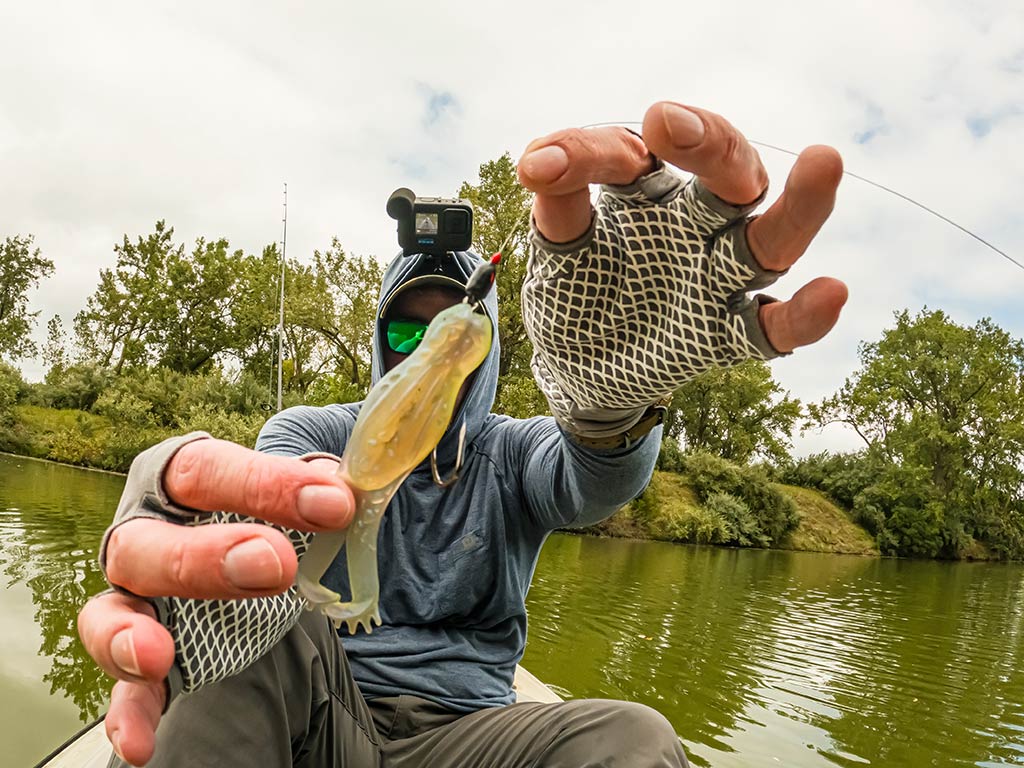
A nice underwater thump is always good. Largemouth Bass feed primarily based on sound and vibration (lateral line). Even if they can’t see, they can eat. Therefore, the dirtier the water, the thumpier my presentation needs to be. The easiest example of this? The classic spinnerbait. In clear water, a willow leaf spinnerbait looks like a fleeing bait fish. But in dirty water, a Colorado blade kicks out much more vibration. It feels like a fleeing bait fish. As you go subsurface, keep this in mind.
Finally, intermittent movement can play a key role. A down-deep pulse is much different than a topwater splash or a subsurface thump. A pulse can start and stop. You can control it. In dirty water, you might opt for a creature bait in a high-vis color, while in clear water, a light weight on a small stickbait could be all that’s needed. Shakey heads can be pulsed on the bottom – and they excel when the Bass can get a good look – but in dirty water, something with a paddle tail raised up and dropped back down to the bottom will get more attention and bites.
Be prepared for these different situations so you’re not caught off guard. You never want to take too much, but fathers who invest time into learning about fishing techniques for every feeding strategy will be ahead of the curve, skipping the guesswork and getting right to catching.
Bonus: Fishing Tips for Busy Dads
Here are a few tips for anglers with limited time that will help you make the most of your time on the water, since dads don’t have a moment to waste:
- Prep the night before. Look at the radar, weather forecast, and any depth or flow gauges available online.
- Prepare gear for two locations that are distinctly different from one another.
- Scan the area upon arrival. Where is the wind stacking trash? Do you notice any bird or bait fish activity? Look for life.
- Look for active fish and start on top. Make lots of casts. If nothing happens after you’ve given it a fair shake, continue searching subsurface. Nothing? Slow down, go deep, and dissect the area.
- Fish the conditions that the day has given you. Don’t force either a location or a presentation. If you need to pivot, you’re ready!
Fathers Who Go Fishing: It’s All in the Planning!
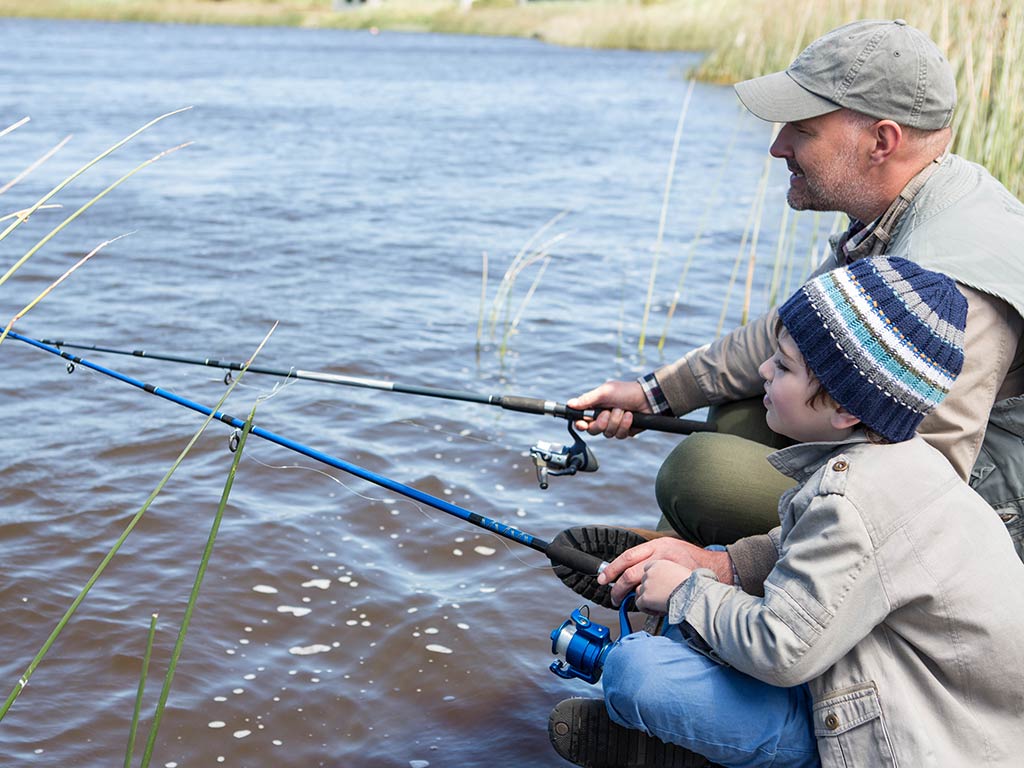
When the weather ruins plan A, the most dangerous fisherman isn’t the one with the most stuff – it’s the one with the best options. Build your fishing portfolio to get ready to make the most of your limited time! Travel light and stay flexible. The next time the river rises or the lake shuts down, you’ll be ready to adjust on the fly. You’ll be the most effective kind of fatherly fisherman – one who can adapt.
Tight lines and Godspeed, patriots!
Are you a fishing father? What are your tips to make the most of your time on the water? We’d love to hear from you in the comments below!
